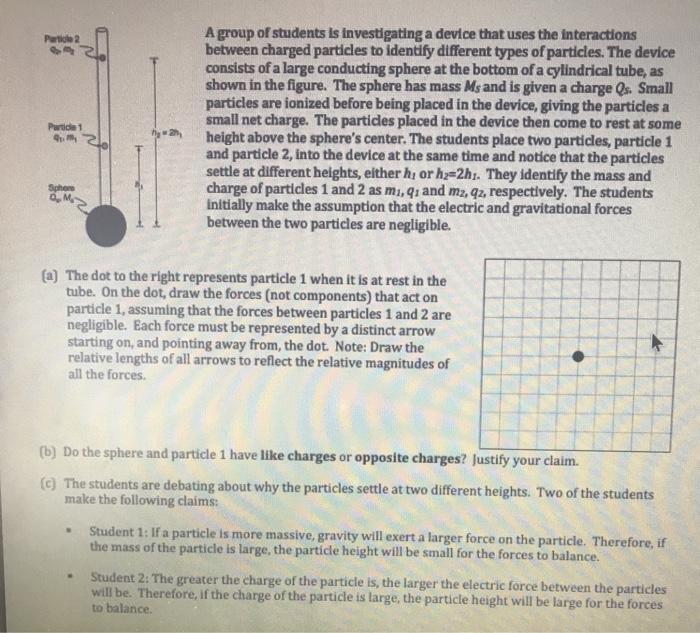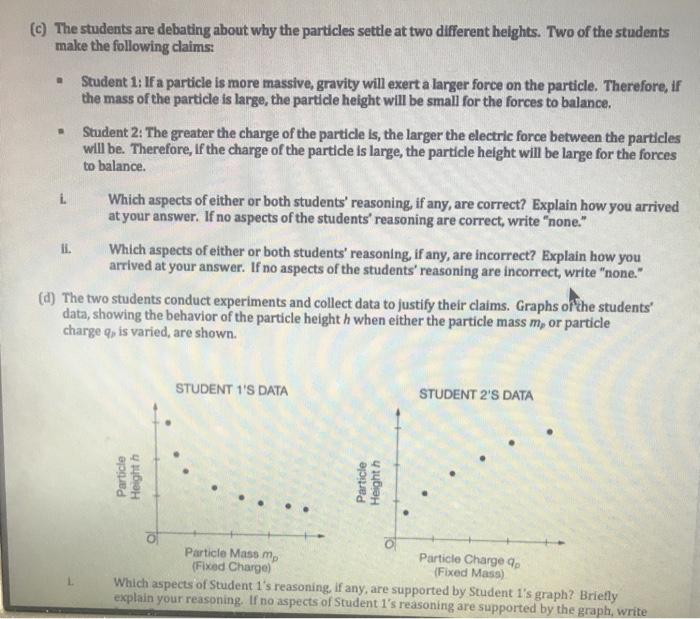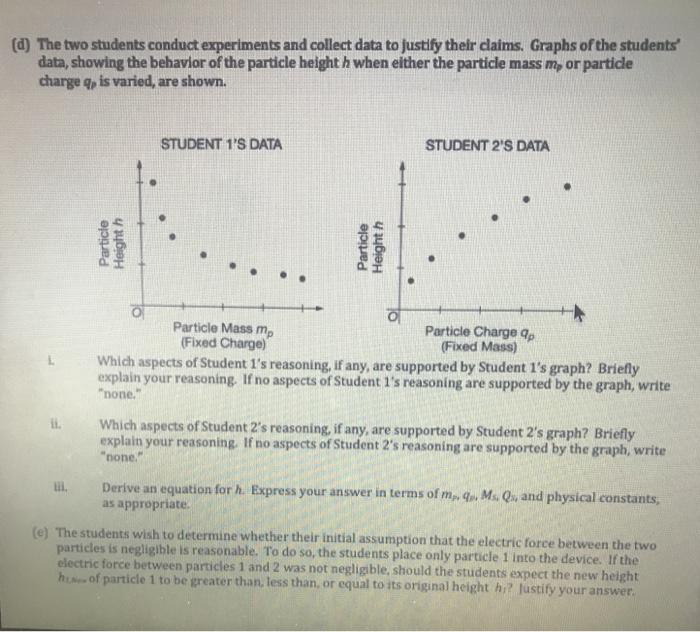Answered step by step
Verified Expert Solution
Question
1 Approved Answer
A group of students is investigating a device that uses the interactions between charged particles to identify different types of particles. The device consists



A group of students is investigating a device that uses the interactions between charged particles to identify different types of particles. The device consists of a large conducting sphere at the bottom of a cylindrical tube, as shown in the figure. The sphere has mass Ms and is given a charge Qs. Small particles are ionized before being placed in the device, giving the particles a small net charge. The partides placed in the device then come to rest at some height above the sphere's center. The students place two particles, particle 1 and particle 2, into the device at the same time and notice that the particles settle at different heights, either h, or hz=2h1. They identify the mass and charge of particles 1 and 2 as mi, q1 and m2, q2, respectively. The students Initially make the assumption that the electric and gravitational forces between the two particles are negligible. Partidle 2 Partide 1 Sphem (a) The dot to the right represents particle 1 when it is at rest in the tube. On the dot, draw the forces (not components) that act on particle 1, assuming that the forces between particles 1 and 2 are negligible. Each force must be represented by a distinct arrow starting on, and pointing away from, the dot. Note: Draw the relative lengths of all arrows to reflect the relative magnitudes of all the forces. (b) Do the sphere and particle 1 have like charges or opposite charges? Justify your claim. (c) The students are debating about why the particles settle at two different heights. Two of the students make the following claims: Student 1: If a particle is more massive, gravity will exert a larger force on the particle. Therefore, if the mass of the particle is large, the partidle height will be small for the forces to balance. Student 2: The greater the charge of the particle is, the larger the electric force between the particles will be. Therefore, if the charge of the particle is large, the particle height will be large for the forces to balance. (c) The students are debating about why the particles settle at two different heights. Two of the students make the following claims: Student 1: If a particle is more massive, gravity will exert a larger force on the particle. Therefore, if the mass of the particle is large, the partide height will be small for the forces to balance. Student 2: The greater the charge of the particle is, the larger the electric force between the particles will be. Therefore, If the charge of the partidle is large, the particle height will be large for the forces to balance. Which aspects of either or both students' reasoning, if any, are correct? Explain how you arrived at your answer. If no aspects of the students' reasoning are correct, write "none." Which aspects of either or both students' reasoning, if any, are incorrect? Explain how you arrived at your answer. If no aspects of the students' reasoning are incorrect, write "none." (d) The two students conduct experiments and collect data to justify their claims. Graphs of the students' data, showing the behavior of the particle height h when either the particle mass m, or particle charge q, is varied, are shown. STUDENT 1'S DATA STUDENT 2'S DATA of Particle Mass m, (Fixed Charge) Particle Charge q. (Fixed Mass) Which aspects of Student 1's reasoning, if any, are supported by Student 1's graph? Briefly explain your reasoning. If no aspects of Student l's reasoning are supported by the graph, write Particle Height h Particle Height h (d) The two students conduct experiments and collect data to justify their claims. Graphs of the students data, showing the behavior of the particle height h when either the particle mass m, or particle charge q, is varied, are shown. STUDENT 1'S DATA STUDENT 2'S DATA Particle Mass m, (Fixed Charge) Particle Charge p (Fixed Mass) Which aspects of Student l's reasoning, if any, are supported by Student l's graph? Briefly explain your reasoning. If no aspects of Student 1's reasoning are supported by the graph, write "none." ii. Which aspects of Student 2's reasoning, if any, are supported by Student 2's graph? Briefly explain your reasoning. If no aspects of Student 2's reasoning are supported by the graph, write "none." Derive an equation for h. Express your answer in terms of m,, q, Ms. Q, and physical constants, as appropriate. (e) The students wish to determine whether their initial assumption that the electric force between the two particles is negligible is reasonable. To do so, the students place only particle 1 into the device. If the electric force between particles 1 and 2 was not negligible, should the students expect the new height huof particle 1 to be greater than, less than, or equal to its original height hi? Justify your answer. Particle Height h Particle Height h
Step by Step Solution
★★★★★
3.47 Rating (154 Votes )
There are 3 Steps involved in it
Step: 1
Solution a Force due to gravity directed downwards is balanced by the electrostatic ...
Get Instant Access to Expert-Tailored Solutions
See step-by-step solutions with expert insights and AI powered tools for academic success
Step: 2

Step: 3

Ace Your Homework with AI
Get the answers you need in no time with our AI-driven, step-by-step assistance
Get Started


